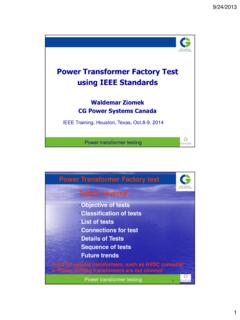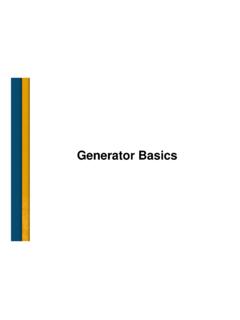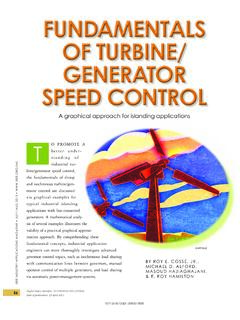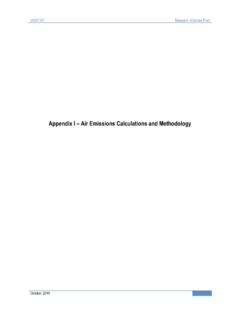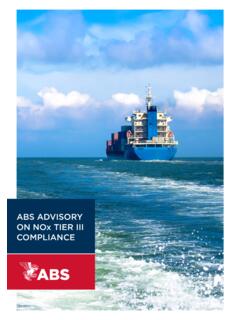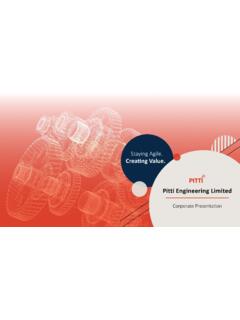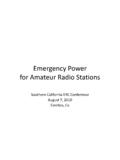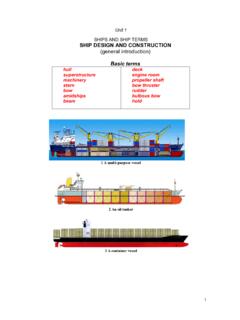Transcription of Electrical Design Considerations for Offshore Installations
1 Electrical Design Considerations for Offshore Installations Presented by: Mike Alford, Stan Beaver, & Chris Migl Introduction This seminar is intended to present a high level view and set a stage for further review of differences and specific requirements of Offshore Electrical Installations Discussions of the codes, standards, and regulatory requirements will present our interpretation of present requirements; however, in addition to the expected changes in codes and standards, agreements of jurisdiction between regulatory agencies are also being revised. It is imperative that the authorities have jurisdiction (BSEE.)
2 &USCG) be contacted early during the Design phase to clearly define the regulatory and standard requirements. During this seminar, we will concentrate on manned Offshore US requirements What's Different About Offshore ? Surrounded by sea and hydrocarbons No place to run Logistics difficult - Materials by Supply Boat - Personnel Transfers by Chopper - Escape in Chopper or in Survival Craft/Raft - Offshore work costs 5x to 10x what it would onshore Expensive real estate - Hull costs $12 for each pound it floats Relatively Small Footprint - Buildings Cramped - Tight Equipment Spacing - Material Handling Issues - Studies a Must What's Different About Offshore ?
3 Hostile Marine Environment - Humid - Salty and Corrosive Extreme weather conditions - Hurricanes and Typhoons - 160 mph wind criteria Marine Motions for Floater - Pitch and Roll - Lateral and Vertical Accelerations Emergency Equipment designed for +/- pitch and roll So is Realistic? The Offshore Marine Environment Environment is the enemy Offshore ! Salty Sea spray, constant humidity, and hot sun. Condensing moisture several hours per day - complete electrolytic cell (anode, cathode, metallic path, path for ionization). Dissimilar metal galvanic corrosion is exacerbated - Aluminum sacrificial (anodic) to mild steel - Mild steel sacrificial (anodic) to Stainless Steel All equipment breathes (including NEMA 7).
4 The Offshore Marine Environment (cont). Careful selection of equipment, Design and materials for equipment exposed to the elements is essential Electrical equipment in controlled environment wherever possible. Stainless Steel, non-metallic materials (fiberglass, etc) and coated copper-free . aluminum (< ). Severe-service coatings and Design (motors, generators, transformers). TEFC, TEAAC and TEWAC enclosures VPI insulation (motors, generators). Space heaters in switchgear, motors, generators, transformer chambers, etc. Stainless Steel Hardware Stainless Steel valved fins for transformer radiators The Offshore Marine Environment (cont).
5 Equipment, Design and Material Selection (cont). IP-56 / NEMA 4X ratings for equipment Sealed contacts for equipment located outdoors Breather / drains in boxes and enclosures Seal welding instead of stitch welding (large generators, motors, stanchions). Galvanic isolation of aluminum from mild steel Standardization of outdoor equipment - robustness . - corrosion-resistance - risk mitigation against hydrocarbon releases The Offshore Marine Environment (cont). The Offshore Marine Environment (cont). The Offshore Marine Environment (cont). The Offshore Marine Environment (cont). The Offshore Marine Environment (cont).
6 The Offshore Marine Environment (cont). The Offshore Marine Environment (cont). The Offshore Marine Environment (cont). The Offshore Marine Environment (cont). Platform Types Pics of Jacketed (Fixed), Semisub and SPAR. Codes and Standards US Waters Common (Floaters and Fixed). BSEE Jurisdiction - CFR 30. NFPA 70 NEC (Chevron uses art. 500 / BP uses art. 505). NFPA70E. API RP 14F and 14FZ (Chevron uses 14F / BP uses 14FZ). [Note: USCG CFR's do not reference 14F/FZ]. API RP 500 and 505 (Chevron uses RP 500 / BP uses RP 505). Coast Guard Jurisdiction - CFR 46. Aids to Navigation fog signal and obstruction lights per USCG requirements Abandon platform and general alarm system per USCG requirements Codes and Standards (cont).
7 US Waters Additional Requirement for Floaters . USCG Letter of Alternate Design 01-13 dated 26 June 2013. (Includes numerous inclusion of IMO standards). IEEE Std 45. Certifying Authority ( , DNV, Lloyds, ABS MODU, etc). [Note: MODU pertains to facilities with and without drilling]. Joint BSEE/USCG jurisdiction - BSEE Memoranda of Agreement and Understanding with USCG. EPA requirements for diesel engines (Tier emission ratings). Codes and Standards (cont). International Waters IMO (International Maritime Organization). SOLAS (Safety of Life at Sea). IEC Standards ( , IEC 61892, IEC 60092, etc.). Requirements of Authority having Jurisdiction.
8 Requirements of Certifying or Classing Authority (ABS, Lloyds, DNV, etc). Certification of Hazardous Area Equipment Certification of Electrical equipment in hazardous areas is subject to requirements of the Authority having Jurisdiction . Gulf of Mexico Fixed Facilities Equipment on fixed production and drilling facilities fall under the authority of BSEE. BSEE Enforces the requirements of API-RP-500/505 and API- RP-14F/14FZ. API-RP-14F/14FZ enforce the requirements of NFPA-70 (NEC). Certification of Hazardous Area Equipment (cont). Gulf of Mexico Floating Facilities Equipment for Marine systems on floating production facilities fall under the authority of USCG.
9 Certifying agencies (such as ABS) may serve as intermediaries between Owner and USCG and may have additional requirements of their own. Equipment for Production/Processing systems on floating and subsea production facilities fall under the authority of BSEE. There is overlap of jurisdiction ( , switchgear that feeds both services) on facilities. Certification of Hazardous Area Equipment (cont). USCG Requirements for Hazardous Areas All equipment installed within hazardous areas must have general NRTL ( Nationally Recognized Testing Laboratory ) certification as Electrical equipment for the type of application.
10 Per NEC, not all Electrical equipment installed within a Division 2. area need be NRTL certified for the specific hazardous area ( junction boxes, cable stuffing glands, motors). All Electrical equipment installed with a hazardous area that does require hazardous area certification per NEC must have NRTL. certification for the specific hazardous area Certification of Hazardous Area Equipment (cont). USCG Requirements for Hazardous Areas (cont). The certifying Nationally Recognized Testing Laboratory must be acceptable to the authorities having jurisdiction for the project. USCG has a web site listing agencies acceptable to them BSEE requires certification to acceptable US standards USCG will accept IEC certification in instances so long as it is tested in a laboratory (IECex certification) to an acceptable standard ( IEC 60079-**).

